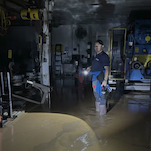The epicenter of the 21st-century oil boom acknowledges fracking is linked to earthquakes
The Canadian province that gave birth to the 21st-century oil boom is no longer waiting to determine whether hydraulic fracturing, or fracking, may be responsible for a recent slew of earthquakes.
Alberta’s energy regulator has issued a new set of “traffic light” rules governing fracking in the province in the wake of two major quakes. All oil producers must now show how fracking could impact local faultlines, and put in place a seismicity monitoring and response program.
If a magnitude 4.0 quake occurs within 5 kilometers of the well, all operations must be halted and can’t be restarted without the province’s consent.
-

-

-

-

-

-

-

-

-

-

-

-

-

-

-

-

-

-

-

-

-

-

-

-

-

-

-

-

-

-

-

-

-

-

-

-

-

-

-

-

-

-

-

-

-

-

-

-

-

-

-

-

-

-

-

-

-

-

-

-

-

-

-

-

-

-

-

-

-

-

-

-

-

-

-

-

-

-

-

-

-

-

-

-

-

-

-

-

-

-

-

-

-

-

-

-

-

-

-

-

-

-

-

-

-

-

-

-












































































































